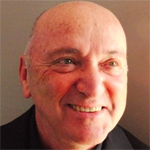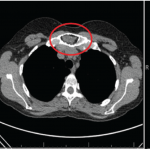Radiographic pressure erosions are late to appear, and MRI is limited by poor resolution for these small lesions. Point-of-care ultrasound is an ideal modality to confirm the presence of a hypoechoic, discrete, well-defined vascular lesion and limit the duration of preoperative morbidity. Access to high-resolution point-of-care ultrasound is suggested as a method of rapid, sensitive, inexpensive confirmation of diagnosis at peripheral sites common for glomus tumor.
 Abraham Chaiton, MD, MSc, FRCPC, RhMSUS, is a graduate of the University of Toronto, where he is an assistant professor in rheumatology. He trained in clinical epidemiology at McMaster University, Hamilton, Ontario, Canada, and as a neuromuscular fellow at Toronto General Hospital. He is a member of the Neurodiagnostic Lab at Humber River Hospital, a founding member and executive staff of the Canadian Rheumatology Ultrasound Society, a past member of the ACR Ultrasound Certification Committee, a member of AANEM Ultrasound Education Committee, active staff at Sunnybrook and Humber River Hospitals, Toronto, and associate staff at Lions Gate Hospital in North Vancouver, B.C. His clinical interests include biologic therapies, myositis, focal nerve entrapments, ultrasound-guided interventions and teaching of POCUS to students and clinicians.
Abraham Chaiton, MD, MSc, FRCPC, RhMSUS, is a graduate of the University of Toronto, where he is an assistant professor in rheumatology. He trained in clinical epidemiology at McMaster University, Hamilton, Ontario, Canada, and as a neuromuscular fellow at Toronto General Hospital. He is a member of the Neurodiagnostic Lab at Humber River Hospital, a founding member and executive staff of the Canadian Rheumatology Ultrasound Society, a past member of the ACR Ultrasound Certification Committee, a member of AANEM Ultrasound Education Committee, active staff at Sunnybrook and Humber River Hospitals, Toronto, and associate staff at Lions Gate Hospital in North Vancouver, B.C. His clinical interests include biologic therapies, myositis, focal nerve entrapments, ultrasound-guided interventions and teaching of POCUS to students and clinicians.
 Maggie Larché, MBChB, MRCP, PhD, is an associate professor in the Divisions of Rheumatology and Clinical Immunology and Allergy in the Department of Medicine & Pediatrics at McMaster University and staff Physician at St. Joseph’s Hospital in Hamilton, Ontario, Canada. Following a PhD from Imperial College, London, she trained in rheumatology in London, U.K. She is a founding member and past president of the Canadian Rheumatology Ultrasound Society and chair of the Hamilton Scleroderma Group. Her major clinical interest is in scleroderma and early inflammatory arthritis, with research interests in cellular biomarkers and ultrasonographic and MR imaging in inflammatory arthritis.
Maggie Larché, MBChB, MRCP, PhD, is an associate professor in the Divisions of Rheumatology and Clinical Immunology and Allergy in the Department of Medicine & Pediatrics at McMaster University and staff Physician at St. Joseph’s Hospital in Hamilton, Ontario, Canada. Following a PhD from Imperial College, London, she trained in rheumatology in London, U.K. She is a founding member and past president of the Canadian Rheumatology Ultrasound Society and chair of the Hamilton Scleroderma Group. Her major clinical interest is in scleroderma and early inflammatory arthritis, with research interests in cellular biomarkers and ultrasonographic and MR imaging in inflammatory arthritis.
References
- Lee W, Kwon SB, Cho SH, et al. Glomus tumor of the hand. Arch Plast Surg. 2015 May;42(3):295–301.
- Gombos Z, Zang PJ. Glomus tumor. Arch Pathol Lab Med. 2008 Sep;132(9):1448–1452.
- Nazerani S, Motamedi MKM, Keramati MR. Diagnosis and management of glomus tumors of the hand. Tech Hand Up Extrem Surg. 2010 Mar;14(1):8–13.
- Motandon C, Costa JD, Dias LA, et al. Tumores glomicos subunguearis. Radiol Bras. 2009;42(6):371–374.
- Marchadier A, Cohen M, Legre R. [Subungual glomus tumors of the fingers; ultrasound diagnosis.] Chir Main. 2006 Feb;25(1):16–21.
- Tuncali D, Yilmaz AC, Terzioglu A, Aslan G. Multiple occurrences of different histologic types of glomus tumor. J Hand Surg Am. 2005 Jan;30(1):161–164.
- McDermott EM, Weiss APC. Glomus tumors. J Hand Surg Am. 2006 Oct;31(8):1397–1400.
- Hildreth DH. The ischemic test for glomus tumor: A new diagnostic test. Review of Surg. 1970 Mar–Apr;27(2):147–148.
- Love JG, Glomus tumors: Diagnostic and treatment. Proc Staff Meet, Mayo Clinic. 1944;19:113–116.
- Netscher DT, Aburto J, Koepplinger M. Subungual glomus tum0or. J Hand Surg Am. 2012 Apr;37(4):821–823.
- Kim DH. Glomus tumor of the finger tip and MRI appearance. Iowa Orthopaedic J. 1999;19:136.
- Tang CYK, Tipoe T, Fung B. Where is the lesion? Glomus tumours of the hand. Arch Plast Surg. 2013 Sep;40(5):492–495.
- Chen SHT, Chen YL, Cheng MH, et al. The use of ultrasonography in preoperative localization of digital glomus tumors. Plast Recon Surg. 2003 Jul;112(1):115–119, discussion 120.
- Espinoze-Gutierrez A, Izaquirre A, Baena-Ocampo L, et al. Glomus tumor. J Rheumatol. 2009 Jun;36(6):1343–1344.
Disclosure
Drs. Chaiton and Larché have both received honoraria related to teaching ultrasonography courses through the Canadian Rheumatology Ultrasound Society from 2010–present.


